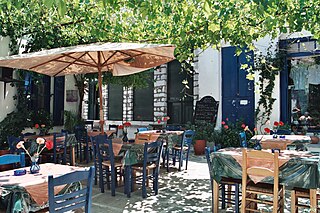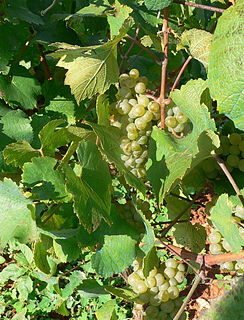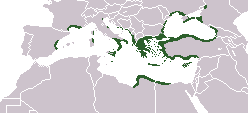
Greek cuisine is a Mediterranean cuisine. Contemporary Greek cookery makes wide use of vegetables, olive oil, grains, fish, wine, and meat. Other important ingredients include olives, pasta, cheese, lemon juice, herbs, bread and yoghurt. The most commonly used grain is wheat; barley is also used. Common dessert ingredients include nuts, honey, fruits, and filo pastries. It is strongly influenced by Ottoman cuisine and thus, especially cuisine of anatolian Greeks shares foods such as baklava, tzatziki, gyro, moussaka, dolmades, yuvarlakia and keftethes with the neighboring countries. To an even greater extent it is influenced by Italian cuisine and cuisines from other neighboring south European countries, and thus, especially in southern regions and the islands it includes several kinds of pasta, like hyllopites, gogkes and tziolia.

Malvasia is a group of wine grape varieties grown historically in the Mediterranean region, Balearic Islands, Canary Islands and the island of Madeira, but now grown in many of the winemaking regions of the world. In the past, the names Malvasia, Malvazia, and Malmsey have been used interchangeably for Malvasia-based wines; however, in modern oenology, "Malmsey" is now used almost exclusively for a sweet variety of Madeira wine made from the Malvasia grape. Grape varieties in this family include Malvasia bianca, Malvasia di Schierano, Malvasia negra, Malvasia nera, Malvasia nera di Brindisi, Malvasia di Candia aromatica, Malvasia odorosissima, and a number of other varieties.

The Muscat family of grapes includes over 200 grape varieties belonging to the Vitis vinifera species that have been used in wine production and as raisin and table grapes around the globe for many centuries. Their colors range from white, to yellow, to pink to near black. Muscat grapes and wines almost always have a pronounced sweet floral aroma. The breadth and number of varieties of Muscat suggest that it is perhaps the oldest domesticated grape variety, and there are theories that most families within the Vitis vinifera grape variety are descended from the Muscat variety.

Aglianico is a black grape grown in the southern regions of Italy, mostly Basilicata and Campania.

Agiorgitiko is a red Greek wine grape variety that, as of 2012, was the most widely planted red grape variety in Greece, ahead of Xynomavro. The grape has traditionally been grown in the Nemea region of the Peloponnese but can be found throughout the country including Attikí (Attica) and Makedonía (Macedonia).
Negroamaro, is a red wine grape variety native to southern Italy. It is grown almost exclusively in Apulia and particularly in Salento, the peninsula which can be visualised as the “heel” of Italy. The grape can produce wines very deep in color. Wines made from Negroamaro tend to be very rustic in character, combining perfume with an earthy bitterness. The grape produces some of the best red wines of Apulia, particularly when blended with the highly scented Malvasia Nera, as in the case of Salice Salentino.

Assyrtiko or Asyrtiko is a white Greek wine grape indigenous to the island of Santorini. Assyrtiko is widely planted in the arid volcanic-ash-rich soil of Santorini and other Aegean islands, such as Paros. It is also found on other scattered regions of Greece such as Chalkidiki.

Xinomavro is the principal red wine grape of the uplands of Naousa in the regional unit of Imathia, and around Amyntaio, in Macedonia, Greece. This grape is primarily cultivated in Naousa, Goumenissa, Amyntaio, Rapsani, Trikomo, Siatista, Velventos, and, on a lesser scale, on Mount Athos, at Ossa, Ioannina, Magnesia, Kastoria and Trikala. In 2010, the total global cultivated area was 1,971 hectares and was entirely in Greece, but by 2013 this had grown to 2,239 hectares worldwide, with some initial plantings in Gansu, China.

Zivania or zivana is a Cypriot pomace brandy produced from the distillation of a mixture of grape pomace and local dry wines made from Xynisteri and Mavro grapes.Zivania is colourless and alcoholic with a light aroma of raisins. Its alcohol content varies, with 45% by volume being the typical value. Zivania contains no sugars and has no acidity.

Muscat Blanc à Petits Grains is a white wine grape of Greek origin that is a member of the Muscat family of Vitis vinifera. Its name comes from its characteristic small berry size and tight clusters. It is known under a variety of local names such as Moscato bianco, Muscat blanc, Muscat Canelli, Muscat de Frontignan, Muscat de Lunel, Muscat d'Alsace, Muskateller, Moscatel de Grano Menudo, Moscatel rosé and Sárgamuskotály .

Gaglioppo is a red wine grape that is grown in southern Italy, primarily around Calabria. The vine performs well in drought conditions but is susceptible to oidium and peronospora. The grape produces wine that is full-bodied, high in alcohol and tannins with a need for considerable time in the bottle for it to soften in character. It is sometimes blended with up to 10% white wine.
Savatiano is a white Greek wine grape used primarily in the wine Retsina. It is one of Greece's most widely planted grape varieties and is known for its resistance to drought condition. It is mostly planted throughout central Greece, particularly in Attica near Athens. In Retsina, the naturally low acidity of the grape is sometimes compensated for by the addition of Assyrtiko and Rhoditis in the blend.

The influence of wine in ancient Greece helped ancient Greece trade with neighboring countries and regions. Many mannerisms and cultural aspects were associated with wine. It led to great change in Ancient Greece as well.
Limnio (LIM-nee-oh) is a red Greek wine grape variety that is indigenous to the Greek island of Lemnos. The grape has had a long history of wine production that may extend back to Ancient Greece with wine historians widely believing it was the grape variety, Lemnia, that was described by Aristotle as producing the famous red Lemnian wine. According to wine expert Oz Clarke, Limnio is "One of Greece's most important red vines."
Liatiko is an old red Greek wine grape variety that is grown on the island of Crete. While the name suggests a relationship with the Italian variety Aleatico, ampelographers currently discount a connection. Liatiko grapes have a pale red color, are moderate in acidity and rich in aromas and sugars. Liatiko matures in July, a fact that according to one explanation derives its name from Ιουλιάτικο, literally "of July". Historically, the grape has been used in blends with Mandilaria and Kotsifali to produce Malvasia, a very alcoholic, sweet red wine. Malvasia was widely exported by Venetian traders during the Middle Ages and was highly regarded throughout western Europe.
Magliocco Dolce is a red Italian wine grape variety that is grown mostly in the Calabria region of southern Italy. In agricultural census counts, plantings of Magliocco Dolce are often grouped with the related, but distinct, red grape variety Magliocco Canino. Throughout history, numerous red southern Italian wine grape varieties have been variously known under the synonyms of "Magliocco" or "Magliocchi", most notably Gaglioppo, but recent DNA analysis has shown those grapes to be unrelated to Magliocco Dolce or Magliocco Canino.
Grisa nera is a red Italian wine grape variety that is grown in the Piedmont wine region of northwest Italy where it is used in both winemaking and as a table grape. The grape is most often used as a minor blending component with wines made from Barbera, Neretta Cuneese and Plassa.
Alionza is a white Italian wine grape variety that is grown in the Emilia-Romagna region of north central Italy, where it has a long history of being used since the 14th century as both a table grape and blending grape for wine production. While sometimes confused with the Greek wine grape Sklava, DNA analysis in the early 21st century has suggested, instead, that Alionza may be closely related to the Tuscan wine grape Trebbiano.















